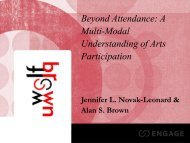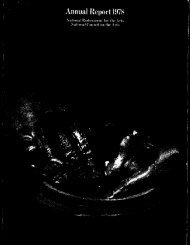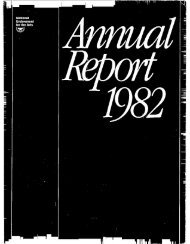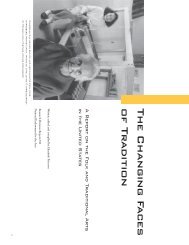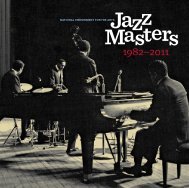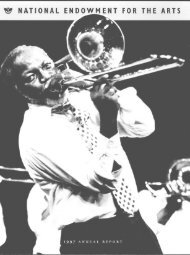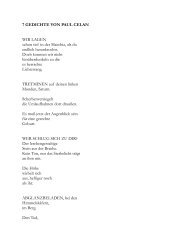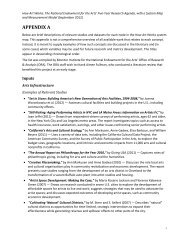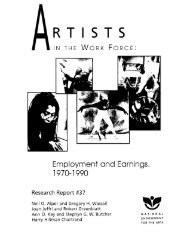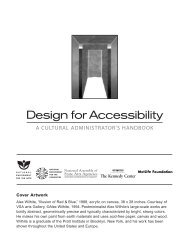You also want an ePaper? Increase the reach of your titles
YUMPU automatically turns print PDFs into web optimized ePapers that Google loves.
Policy Research&Analysis<br />
1999 ANNUAL REPORT<br />
The Office of Policy Research & Analysis (OPRA) supports <strong>the</strong> Chairman and NEA staff with<br />
statistical and o<strong>the</strong>r in<strong>for</strong>mation about <strong>the</strong> agency’s applications and awards, including<br />
grantee and applicant profiles, <strong>the</strong> distribution of awards by state and artistic discipline, and<br />
analyses of overall trends in NEA funding. The Office’s Research Division issues periodic<br />
reports on larger issues affecting artists and arts organizations that are distributed to<br />
Congress, <strong>the</strong> arts community and <strong>the</strong> public. These reports help shape changes in <strong>the</strong><br />
<strong>Endowment</strong>’s grantmaking policies.<br />
I<br />
n Fiscal Year 1999, one of OPRA’s major projects<br />
was <strong>the</strong> development of a geographic database that<br />
provides a comprehensive picture of <strong>the</strong> broad reach of<br />
NEA-supported activities. The database demonstrated that<br />
over 4,000 cities and towns throughout <strong>the</strong> country benefited<br />
from NEA grants through dance company tours,<br />
symphony and opera presentations in schools, poetry<br />
readings in libraries, national distribution of works by small literary presses, traveling exhibitions<br />
of works by major visual artists, and radio and television broadcasts.<br />
As part of its activities, OPRA oversees <strong>the</strong> agency’s Civil Rights Office, which reflects <strong>the</strong> Chairman’s<br />
commitment to equity within <strong>the</strong> <strong>Endowment</strong> and with its grantees, applicants and <strong>the</strong> cultural<br />
community. Working with OPRA, <strong>the</strong> Civil Rights Office monitors and influences agency-wide policy<br />
and practices.<br />
In 1999, OPRA’s Research Division published <strong>the</strong> following studies:<br />
The NEA’s new geographic<br />
database demonstrated that<br />
in Fiscal Year 1999, 4,000<br />
American communities<br />
benefited from NEA grants.<br />
• Note #72, an updated analysis of public arts participation across states, regions and metropolitan<br />
areas based on <strong>the</strong> Division’s 1997 <strong>National</strong> Survey of Public Participation in <strong>the</strong> <strong>Arts</strong>;<br />
• Note #73, an analysis of artist employment based on statistics collected through <strong>the</strong> U.S.<br />
Bureau of Labor Statistics’ Current Population Survey; and<br />
• Note #74, a summary of <strong>the</strong> latest research comparing government arts expenditures in <strong>the</strong><br />
U. S. with spending levels in nine o<strong>the</strong>r countries.<br />
OPRA also convened a symposium with researchers and representatives of arts service organizations<br />
and foundations that assessed <strong>the</strong> development of a national unified database of arts organizations.<br />
The NEA’s library, part of <strong>the</strong> Research Division, continued to collect and make available to <strong>the</strong><br />
arts field and <strong>the</strong> public specialized in<strong>for</strong>mation about topics in <strong>the</strong> arts.<br />
31



